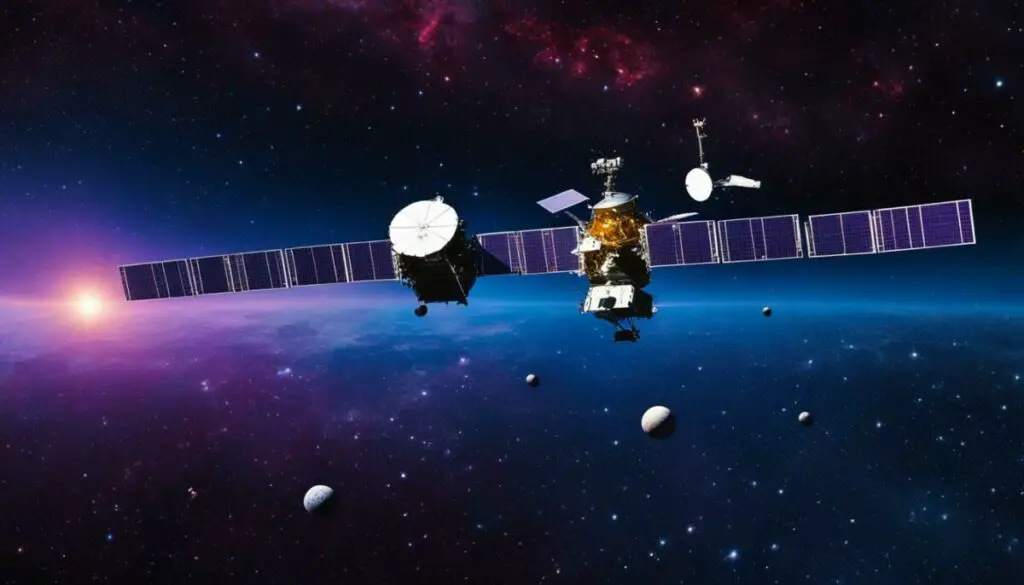Last Updated on 4 months by Francis
Welcome to our fascinating exploration of ultraviolet and infrared colors. These hidden hues exist in the electromagnetic spectrum, alongside gamma rays, X-rays, visible light, microwaves, and radiowaves. While not visible to the human eye, ultraviolet and infrared colors play a crucial role in our understanding of light and the universe. Join us as we delve into the secrets of these invisible colors and their significance in the world we inhabit.
Contents
Key Takeaways:
- Ultraviolet and infrared are “colors” that are not visible to the human eye.
- These hidden colors are part of the electromagnetic spectrum, which also includes visible light.
- Special instruments and detectors are needed to detect and study ultraviolet and infrared wavelengths.
- The European Space Agency uses satellites to observe the universe in all ranges of the electromagnetic spectrum.
- Exploring ultraviolet and infrared colors expands our understanding of light and the cosmos.
The Discovery of Ultraviolet and Infrared Light

Through a series of groundbreaking experiments utilizing prisms and thermometers, scientists were able to make a remarkable discovery – the existence of different colors of light beyond the visible spectrum. These experiments played a pivotal role in deepening our understanding of the properties of infrared and ultraviolet light, ultimately expanding our knowledge of the vast electromagnetic spectrum and its intriguing phenomena.
By passing light through prisms, researchers observed the separation of white light into a mesmerizing spectrum of colors. This revelation led to the recognition that there is more to light than meets the human eye. Infrared light, with longer wavelengths than visible light, was found to lie just beyond the red end of the spectrum. In contrast, ultraviolet light, with shorter wavelengths, was discovered just beyond the violet end.
Thermometers played another crucial role in unraveling the distinct properties of these hidden “colors” of light. Scientists observed that the heat generated by different colors varied, providing insight into the unique characteristics of infrared and ultraviolet light.
“The discovery of these previously unknown colors revolutionized our understanding of light and the electromagnetic spectrum. It opened a new window into the hidden wonders of the universe.”
The implications of this groundbreaking discovery are far-reaching. It has broadened our understanding of light and its fundamental nature, while also expanding our exploration of the cosmos. The ability to detect and study infrared and ultraviolet light has proven essential for gaining insights into various astronomical phenomena, unraveling the mysteries of distant celestial objects, and advancing our knowledge of the universe as a whole.
As we continue to delve deeper into the realm of light, our understanding of the electromagnetic spectrum grows, offering infinite possibilities for exploration and discovery.
The Electromagnetic Spectrum
The electromagnetic spectrum encompasses a wide range of different wavelengths and frequencies, including visible light, ultraviolet (UV) light, and infrared (IR) light. Understanding the electromagnetic spectrum is crucial in unraveling the nature of light and its role in the universe.
At its core, the electromagnetic spectrum consists of electromagnetic waves, which are characterized by their wavelength and frequency. Wavelength refers to the distance between two consecutive peaks or troughs of a wave, while frequency represents the number of wave cycles that occur in a given time period.
Visible light is just a small portion of the electromagnetic spectrum that human eyes can perceive. It spans a range of wavelengths where different wavelengths appear as different colors to our visual system. The ultraviolet region lies beyond the violet end of the visible light spectrum and is characterized by shorter wavelengths and higher frequencies than visible light. On the other end of the spectrum, the infrared region extends beyond the red end of visible light and is distinguished by longer wavelengths and lower frequencies.
To provide a clearer understanding, let’s take a look at the different regions of the electromagnetic spectrum:
1. Visible Light Region
Wavelength: 400 – 700 nanometers (nm)
The visible light region is the range of wavelengths that our eyes can detect, allowing us to perceive different colors. This region is composed of the familiar colors of the rainbow, including red, orange, yellow, green, blue, indigo, and violet. Each color corresponds to a specific wavelength within this range. For example, red light has a longer wavelength, while violet light has a shorter wavelength.
2. Ultraviolet Region
Wavelength: less than 400 nm
The ultraviolet region occupies the portion of the electromagnetic spectrum that lies beyond the violet end of visible light. It is invisible to the human eye, but it plays a significant role in many aspects of science and technology. UV light has shorter wavelengths and higher frequencies than visible light, making it capable of causing sunburns, influencing chemical reactions, and aiding in forensic investigations.
3. Infrared Region
Wavelength: greater than 700 nm
The infrared region lies beyond the red end of visible light and is also invisible to the human eye. It consists of longer wavelengths and lower frequencies compared to visible light. Infrared light has various applications, including thermal imaging, communication systems, and remote sensing. It can detect heat emitted by objects, making it useful in identifying temperature variations and studying the properties of different materials.
By understanding the different regions of the electromagnetic spectrum, we gain insight into the vast range of wavelengths and frequencies that exist beyond what our eyes can see. This knowledge is crucial in fields such as astronomy, telecommunications, and medical imaging, where the utilization of UV and IR light allows us to explore and understand the world around us.
Perceiving Color and the Spectrum

In understanding the perception of color, it’s essential to consider the physical processes that occur within the human eye. Color perception is a result of the stimulation of light detectors called cones in the retina. These cones respond to different wavelengths of light and transmit signals to the brain, enabling us to perceive colors.
When discussing color, spectrally pure or monochromatic colors are significant. These colors are produced by passing white light through a prism, which separates the light into its constituent wavelengths. Each wavelength corresponds to a specific color in the visible spectrum. Mixing white with spectrally pure colors creates colors with varying hues and saturation.
Hue refers to the attribute that distinguishes one color from another on the color spectrum. Saturation, on the other hand, describes the intensity or purity of a color. Colors with high saturation appear vivid and vibrant, while colors with low saturation appear more muted. Chroma is another term used to describe the intensity of a color, similar to saturation, but with a slightly different interpretation.
The perception of lightness or brightness, known as luminance, can also affect our perception of color. The same hue can appear different when presented in different levels of brightness. For example, a light pink hue may appear brighter when surrounded by darker colors and vice versa.
Overall, the perception of color can be defined by three parameters: hue, saturation, and luminance. These parameters combine to create a rich and diverse color palette that shapes our visual experiences and interactions with the world around us.
Understanding color perception and its relationship to the spectrum is crucial for various fields, including art, design, psychology, and marketing. The impact of colors on human emotions and behavior has been extensively studied, highlighting the importance of color choices in various contexts.
Next, we’ll explore the role of prisms and thermometers in furthering our understanding of light in Section 5: The Role of Prisms and Thermometers in Understanding Light.
The Role of Prisms and Thermometers in Understanding Light

Experiments with prisms and thermometers have played a crucial role in advancing our understanding of light. Through these experiments, scientists have been able to uncover the properties of light and gain valuable insights into its behavior.
One of the key experiments involves passing light through prisms. Prisms are able to separate light into its constituent colors, revealing the different wavelengths that make up the visible spectrum. By analyzing the colors produced by the prism, researchers can study the various properties of light, such as its refraction and dispersion.
“The use of prisms in light experiments has revolutionized our understanding of the behavior of light. It allows us to see the different colors that make up visible light and provides insights into its interaction with different materials.”
– Dr. Sarah Thompson, Light Scientist
Thermometers, on the other hand, have been instrumental in measuring the heat generated by different colors of light. By using thermometers to detect and quantify the thermal energy produced by light, scientists can further explore the relationship between light and heat.
Together, these experiments with prisms and thermometers have deepened our understanding of light and its properties. They have paved the way for advancements in various fields, including optics, physics, and even photography.
The Nature of Light Through Prism Experiments
When light passes through a prism, it undergoes refraction and dispersion. Refraction refers to the bending of light as it transitions from one medium to another, such as from air to glass and vice versa. This bending effect separates the different colors of light, which become visible as a rainbow-like spectrum.
Dispersion, on the other hand, refers to the spreading out of light as it passes through a medium. This phenomenon further accentuates the separation of colors when light is refracted by the prism.
The use of prisms in light experiments has allowed scientists to investigate phenomena such as chromatic aberration, where different colors of light focus at different points. Understanding this behavior has, in turn, contributed to the development of lenses and imaging devices that can correct for this effect.
Insights into Light’s Heat Generation Through Thermometer Experiments
Thermometers have proven invaluable in studying the heat generated by different colors of light. By measuring the temperature changes caused by different wavelengths, scientists have been able to discern the relationship between light and heat energy.
These experiments have revealed that different colors of light produce varying amounts of thermal energy. For example, red light tends to generate less heat compared to blue or violet light. This knowledge has practical applications in fields like photography and thermal imaging.
Through experiments with prisms and thermometers, we have gained a deeper understanding of light’s properties and behavior. These insights have not only fueled scientific discoveries but have also influenced technological advancements in various industries. By continuing to explore the mysteries of light, we unravel the secrets of the universe.
The Importance of Detecting Ultraviolet and Infrared Light

Detecting invisible light, such as ultraviolet (UV) and infrared (IR) light, plays a crucial role in studying the universe. These hidden colors, outside the range of human vision, provide valuable insights into various astronomical objects and processes. To capture these invisible colors, special instruments and detectors are essential.
By observing the universe in all ranges of the electromagnetic spectrum, astronomers can gather a wealth of information. The electromagnetic spectrum encompasses a wide range of wavelengths, from gamma rays to radiowaves, with UV and IR falling in between. Each wavelength range reveals unique aspects of cosmic objects, deepening our understanding of the universe.
Scientists use advanced instruments, like UV and IR telescopes, to detect and study these invisible colors. These instruments are designed to capture and analyze the specific wavelengths of UV and IR light. By observing cosmic phenomena in UV and IR, astronomers gain insights into the temperature, composition, and energetic processes occurring within celestial objects.
Advancements in UV and IR Technology
The advancements in UV and IR technology have revolutionized our ability to explore the cosmos. Here are some notable examples:
- UV Photography: UV light is utilized in specialized photography techniques that reveal unique patterns and details, helping scientists study subjects like ancient artifacts and artworks.
- IR Imaging: IR cameras capture thermal images, allowing us to visualize heat differences and identify structural irregularities in various fields, including medicine, building inspection, and electrical systems.
- IR Communication: IR signals are used for wireless communication in devices like remote controls, which transmit commands to TVs, air conditioners, and other appliances.
The applications of UV and IR light extend beyond these examples, with ongoing advancements and discoveries in different industries and scientific fields.
The Significance of Invisible Colors
“Detecting and studying UV and IR light unveils a hidden world of cosmic activity, uncovering new mysteries and deepening our knowledge of the universe.”
By detecting invisible colors, astronomers can explore phenomena that would otherwise remain hidden. UV light allows us to observe the intense emission from young stars, while IR light reveals the cool dust clouds where new stars and planets are forming. Studying these hidden aspects of the cosmos contributes to our understanding of star formation, galaxy evolution, and the overall structure of the universe.
| UV Light | IR Light |
|---|---|
| Reveals the hot, energetic processes occurring in celestial objects. | Provides insights into the cool regions and dust composition within galaxies and star-forming regions. |
| Enables the study of molecules, atoms, and ions in the interstellar medium. | Allows us to observe distant objects and bypass cosmic dust that blocks visible light. |
| Used in detecting and studying ultraviolet color signatures from distant galaxies. | Helps analyze the thermal emissions from cosmic microwave background radiation, revealing clues about the early universe. |
Unveiling the Invisible
The detection and study of UV and IR light through specialized instruments and detectors are essential for unraveling the mysteries of the universe. As technology advances, scientists are constantly pushing the boundaries of exploration, bringing us closer to a comprehensive and awe-inspiring understanding of the cosmos.
Applications of Ultraviolet and Infrared Light

Ultraviolet (UV) light and infrared (IR) light have a wide range of applications across various industries and scientific fields. Let’s explore the diverse uses of these invisible colors in more detail:
UV Light Applications
UV light finds its relevance in multiple areas, including:
- UV Photography: UV photography captures unique, unseen details and patterns, adding an artistic perspective to images. It is often used for creative expressions and scientific documentation.
- Forensic Analysis: UV light plays a crucial role in forensic analysis, aiding investigations through the detection of bodily fluids, fingerprints, and other evidence that may be invisible under normal light.
- Disinfection: UV light is utilized in germicidal lamps to disinfect air, water, and surfaces. It effectively deactivates bacteria, viruses, and molds, making it a valuable tool for sterilization in medical facilities, laboratories, and water treatment plants.
Through these applications, UV light contributes to diverse fields, from art and forensics to public health and sanitation.
IR Light Applications
The uses of IR light extend to various industries and technological advancements:
- Thermal Imaging: IR imaging, also known as thermography, detects and visualizes the infrared radiation emitted by objects to create images based on their temperature. This technology is extensively used for surveillance, building inspections, industrial maintenance, and medical diagnostics.
- Remote Sensing: IR light enables the collection of valuable data about Earth’s surface and atmosphere from a distance. It aids in environmental monitoring, agriculture, weather forecasting, and geological surveys.
- Communication Systems: IR technology is employed in wireless communication systems such as infrared data transmission and remote controls. It enables the transfer of data between devices without the need for physical connections.
IR light’s ability to detect heat and its applications in communication systems contribute to diverse technological advancements.
The Role of UV and IR Technology
UV and IR technology plays a significant role in driving innovation and advancements across industries:
“The applications of UV light and IR light are far-reaching and impactful. They contribute to scientific research, technological advancements, and everyday solutions, improving our understanding of the world and enhancing our quality of life.”
| Applications of UV Light | Applications of IR Light |
|---|---|
| UV Photography | Thermal Imaging |
| Forensic Analysis | Remote Sensing |
| Disinfection | Communication Systems |
By harnessing the power of UV and IR light, we can explore new frontiers in various fields, uncover invisible details, and develop innovative solutions to complex challenges.
Exploring the Cosmos in Different “Colors”

Multi-wavelength observations provide a unique perspective on the cosmos, allowing us to explore the universe in different “colors”. By capturing images of cosmic objects at various wavelengths, scientists can uncover hidden details and gain a comprehensive understanding of the universe.
Through multi-wavelength observations, astronomers can examine cosmic objects, such as stars, galaxies, and nebulae, in different “colors”. Each wavelength range corresponds to specific physical processes and properties, revealing unique information about these celestial entities.
For example, observations in ultraviolet light can provide insights into the formation of stars and the presence of hot, young stars within galaxies. Infrared observations, on the other hand, can unveil the cooler, dust-enshrouded regions where stars are born and planetary systems are formed.
By combining images captured at different wavelengths, astronomers can construct a more detailed and comprehensive view of cosmic objects. This multi-wavelength approach allows for a deeper understanding of the physical processes and phenomena occurring throughout the universe.
Moreover, multi-wavelength observations enable scientists to study the composition, temperature, and magnetic fields of cosmic objects, offering valuable insights into their evolution and dynamics. The ability to delve into the universe in different “colors” opens up new avenues of research and discovery.
Benefits of Multi-wavelength Observations:
- Reveals unique information about cosmic objects
- Enhances understanding of physical processes
- Unveils hidden details and structures
- Provides insights into stellar formation and evolution
- Enables study of composition, temperature, and magnetic fields
The combination of multi-wavelength observations and advanced image processing techniques allows scientists to create stunning astronomical images that capture the awe-inspiring beauty and complexity of the universe. These images, spanning different wavelengths, showcase the diversity and richness of cosmic objects, inspiring curiosity and wonder.
Astronomical Images in Different “Colors”:
| Wavelength | Astronomical Object | Information Revealed |
|---|---|---|
| X-ray | Black Holes | Hot gas emission and accretion disks |
| Ultraviolet | Stellar nurseries | Young, hot stars and star formation regions |
| Visible light | Spiral galaxies | Spatial structure and distribution of stars |
| Infrared | Dust-enshrouded regions | Star birth, planetary systems, and cool, obscured objects |
| Radio waves | Galactic magnetic fields | Distribution and dynamics of cosmic magnetic fields |
These multi-wavelength observations and astronomical images offer a compelling glimpse into the vastness and complexity of the cosmos. By exploring the universe in different “colors”, scientists continue to unravel its mysteries and deepen our understanding of the celestial wonders that surround us.
Advancements in Space Observation

The European Space Agency (ESA) is at the forefront of space exploration, utilizing a fleet of advanced satellites to observe the universe and uncover its mysteries. By employing cutting-edge technology and innovative techniques, ESA’s satellites enable astronomers to obtain a complete picture of the astronomical processes taking place around celestial objects.
Through the careful analysis of data collected from these observations across all ranges of the electromagnetic spectrum, scientists are able to gain valuable insights into the nature of the cosmos. These advancements in space observation contribute to ongoing research and the continuous evolution of our understanding of the universe.
With the assistance of European Space Agency satellites, astronomers are able to capture a variety of data that provides a comprehensive view of astronomical processes. These satellites are equipped with state-of-the-art instruments and detectors that can detect and measure electromagnetic radiation throughout the entire spectrum. This comprehensive approach allows scientists to study the universe in a holistic manner, leaving no stone unturned in their quest for knowledge.
By combining observations from different wavelengths, astronomers are able to piece together a complete picture of the universe and gain insights into various cosmic phenomena. They can study the birth and death of stars, the formation of galaxies, and the behavior of black holes, among other astronomical processes. The data collected by ESA’s satellites provides crucial information that helps unravel the mysteries of the universe and fosters advancements in our understanding of the cosmos.
The technology and expertise provided by the European Space Agency are vital for pushing the boundaries of space exploration and expanding human knowledge. As we continue to observe the universe through the lenses of ESA satellites, we venture further into the realms of the unknown, uncovering new insights and deepening our appreciation for the vastness and complexity of the cosmos.
ESA Satellites and their Contributions:
| Satellite | Mission | Contribution |
|---|---|---|
| Planck | Understanding the Cosmic Microwave Background | Provided detailed data on the oldest light in the universe, helping refine our understanding of the Big Bang. |
| Gaia | Precise Mapping of the Milky Way | Created a 3D map of our galaxy, enabling astronomers to study the structure and evolution of the Milky Way. |
| Hubble Space Telescope | Exploring the Distant Universe | Produced breathtaking images of distant galaxies, stars, and nebulae, expanding our knowledge of the cosmos. |
| Euclid | Investigating Dark Matter and Dark Energy | Aims to unravel the mysteries of dark matter and dark energy, which make up the majority of the universe. |
The Limitations of Human Vision
The human eye is an incredible organ capable of perceiving a wide range of colors. However, it has certain limitations when it comes to detecting colors beyond the visible light spectrum. While we can see colors like red, green, and blue, there are other colors that remain invisible to our eyes.
Beyond the visible light spectrum, there exist invisible colors such as ultraviolet (UV) and infrared (IR). These colors are beyond the range of wavelengths that our eyes can detect. UV light has shorter wavelengths than violet light, while IR light has longer wavelengths than red light. Although we cannot see these colors, they play a significant role in the electromagnetic spectrum and have various applications in different fields.
“The human eye, while remarkable, is limited in its ability to perceive the full range of colors present in the electromagnetic spectrum.”
To study and understand UV and IR colors, special instruments and detectors are necessary. Scientists use advanced technology to detect and analyze these invisible colors. For instance, in astronomy, telescopes equipped with UV and IR detectors can capture images and data that reveal previously unseen aspects of the universe. By going beyond what our eyes can see, we gain a deeper understanding of the cosmos and the intricate processes that shape it.
A Comparison of Visible, Ultraviolet, and Infrared Light
| Light Spectrum | Wavelength Range | Perceived Color | Applications |
|---|---|---|---|
| Visible Light | ~400 to 700 nm | Various colors including red, green, and blue | Photography, art, display technologies |
| Ultraviolet Light | ~10 to 400 nm | Invisible | Forensic analysis, UV photography, disinfection |
| Infrared Light | ~700 nm to 1 mm | Invisible | Thermal imaging, remote sensing, communication systems |
As the table above illustrates, visible light falls within a specific wavelength range (~400 to 700 nm) and encompasses the colors we commonly perceive. UV light has shorter wavelengths, making it invisible to the human eye, while IR light has longer wavelengths, also beyond our visual range.
By acknowledging the limitations of human vision and embracing technology that allows us to explore light beyond what our eyes can see, we unlock a whole new world of discovery. UV and IR colors not only expand our understanding of the electromagnetic spectrum but also find practical applications in fields ranging from medicine and industry to astronomy and beyond.
Conclusion
In conclusion, ultraviolet and infrared are colors that are not visible to the human eye, but they play significant roles in our understanding of the electromagnetic spectrum and the universe. The discovery of these hidden colors through experiments with prisms and thermometers has contributed to our knowledge of light. Advances in technology and space observation allow us to explore the cosmos in different “colors,” providing valuable insights into astronomical processes and objects.
By detecting and studying ultraviolet and infrared light, scientists and astronomers can gather information that is not possible with visible light alone. Instruments and detectors designed specifically for these wavelengths have revolutionized our understanding of the universe and its many phenomena. From UV photography and forensic analysis to thermal imaging and remote sensing, the applications of UV and IR light extend to various industries and scientific fields.
As our understanding of light and the electromagnetic spectrum continues to evolve, new discoveries await us. Exploring the cosmos in different “colors,” beyond what our eyes can see, opens up endless possibilities for uncovering the mysteries of the universe. Through ongoing advancements in technology and space observation, we can strive to obtain a more complete picture of the astronomical processes that shape our cosmos.
FAQ
Are ultraviolet and infrared colors?
No, ultraviolet and infrared are “colors” that are not visible to the human eye. They are part of the electromagnetic spectrum, which includes various wavelengths of light beyond what our eyes can see.
How were ultraviolet and infrared light discovered?
Ultraviolet and infrared light were discovered through experiments using prisms and thermometers. These experiments helped scientists understand the properties of these hidden “colors” and gain a better understanding of the nature of light.
What is the electromagnetic spectrum?
The electromagnetic spectrum is a range of different wavelengths and frequencies. It includes gamma rays, X-rays, ultraviolet, visible light, infrared, microwaves, and radio waves. Visible light is just a narrow range within the spectrum.
How do we perceive color and understand the spectrum?
Color perception is produced by light detectors called cones in the human retina. Spectrally pure or monochromatic colors relate to specific wavelengths. Mixing white with these colors produces various hues and saturation. The perception of lightness or luminance also affects color appearance.
What role did prisms and thermometers play in understanding light?
Experiments with prisms allowed scientists to separate and examine different colors of light. Thermometers helped measure the heat generated by these colors, providing insights into their properties and understanding of light.
Why is it important to detect ultraviolet and infrared light?
Detecting ultraviolet and infrared light is crucial for studying the universe. Special instruments and detectors are needed to capture these invisible colors and gather valuable information about various astronomical objects and processes.
What are the applications of ultraviolet and infrared light?
Ultraviolet light is used in photography, forensic analysis, and disinfection. Infrared light is utilized in thermal imaging, remote sensing, and communication systems. Both UV and IR technology play significant roles in different industries and scientific fields.
How do multi-wavelength observations help explore the cosmos?
Multi-wavelength observations allow us to explore the cosmos in different “colors.” Each wavelength range provides unique information about cosmic objects. By matching images to the corresponding wavelength, scientists can uncover hidden details and gain a comprehensive understanding of the universe.
What advancements have been made in space observation?
The European Space Agency has a fleet of satellites that observe the universe in all ranges of the electromagnetic spectrum. These satellites enable astronomers to obtain a complete picture of the various processes taking place around astronomical objects, contributing to ongoing research and advancements in space exploration.
What are the limitations of human vision?
Beyond the visible light spectrum, there are invisible colors such as ultraviolet and infrared. Special instruments and detectors are necessary to detect and study these colors. Our understanding of the universe is expanded by exploring light beyond what our eyes can see.








